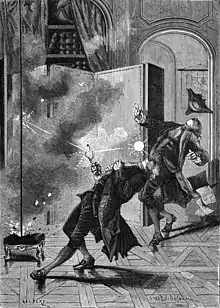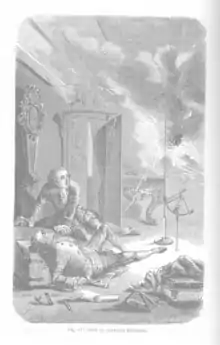Georg Wilhelm Richmann
Georg Wilhelm Richmann (Russian: Георг Вильгельм Рихман) (22 July 1711 – 6 August 1753), (Old Style: 11 July 1711 – 26 July 1753) was a Baltic German physicist. Richmann did pioneering work on electricity, atmospheric electricity, and calorimetry.[1] He died by electrocution in St. Petersburg when struck by apparent ball lightning produced by an experiment attempting to ground the electrical discharge from a storm.

Early life and education
Georg Wilhelm Richmann was born on 22 July 1711 (Old Style, 11 July 1711) in the city of Pernau (today Pärnu, Estonia) in Swedish Livonia. Richmann's father died of plague before he was born, and his mother remarried. In his early years he studied in Reval (today's Tallinn, Estonia); later he studied in Germany at the universities of Halle and Jena.[2]
Career
After his education, Richmann spent the rest of his life as a professor of physics at the university in St. Petersburg and a center of scientific research. There he dealt with problems of thermodynamics and with investigations of electrical phenomena.[3]
He became famous above all for establishing the first general equation for calorimetric calculations.[4][3] This law was later called Richmann's law in his honor.[3]
Richmann also became famous for his investigations on thunderstorm electricity, which led to his tragic death in 1753.[3] Richmann also worked as a tutor to the children of Count Andrei Osterman. Richmann translated Alexander Pope's Essay on Man into German from French, which appeared in 1741. In that year, he was also elected a member of the St. Petersburg Academy of Sciences.
Accidental death
Richmann was electrocuted in St. Petersburg on 6 August 1753 (Old Style, 26 July 1753) while "trying to quantify the response of an insulated rod to a nearby storm."[5] He is said to have been attending a meeting of the Academy of Sciences when he heard thunder, whereupon he ran home with his engraver to capture the event for posterity. While the experiment was underway, a discharge reported to have been ball lightning appeared and collided with Richmann's head leaving him with a red spot on his forehead, his shoes blown open, and parts of his clothes singed. The ball lightning arising from the apparatus was the cause of his death.[6] An explosion followed "like that of a small Cannon"[7] that knocked the engraver out, split the room's door frame, and tore the door off its hinges.[6][8] Richmann was apparently the first person in history to die while conducting electrical experiments.[9]

References
- deutsche-biographie.de
- Georg Wilhelm Richmann from TLÜAR rahvusbibliograafia isikud
- "Georg Wilhelm Richmann in Physik". Lernhelfer (Duden) (in German). Retrieved 2022-10-31.
- Richmann, Willhelm (1750). Novi commentarii Academiae Scientiarum Imperialis Petropolitanae (in Latin).
- Krider, Philip (2006). "Benjamin Franklin and Lightning Rods". Physics Today. American Institute of Physics. 59 (1): 42. Bibcode:2006PhT....59a..42K. doi:10.1063/1.2180176. S2CID 110623159. Retrieved 28 March 2022.
On 6 August 1753, the Swedish scientist Georg Wilhelm Richmann was electrocuted in St. Petersburg while trying to quantify the response of an insulated rod to a nearby storm. The incident, reported worldwide, underscored the dangers inherent in experimenting with insulated rods and in using protective rods with faulty ground connections.
- Some but not all of the preceding details appear in Ronald W. Clarke's presentation of a description by Benjamin Franklin of the accident. See Clarke, Ronald W. (1983). Benjamin Franklin, A Biography. Random House. p. 87. ISBN 978-1-84212-272-3.
- As reported by Sokolov, quoted in Boris N. Menshutkin, Russia's Lomonosov. Chemist, Courtier, Physicist. Princeton, Princeton University Press, 1952, p. 87.
- "Frenchman Thomas François D'Alibard used a 50-foot (15 m) long vertical rod to draw down the "electric fluid" of the lightning in Paris on May 10, 1752. One week later, M. Delor repeated the experiment in Paris, followed in July by an Englishman, John Canton. But one unfortunate physicist did not fare so well. Georg Wilhelm Reichmann attempted to reproduce the experiment, according to Franklin's instructions, standing inside a room. A glowing ball of charge traveled down the string, jumped to his forehead and killed him instantly—providing history with the first documented example of ball lightning in the process."
- Swarup, Amarendra (7 June 2006). "Physicists Create Great Balls of Fire". New Scientist. Archived from the original on 19 July 2006. Retrieved 28 March 2022.